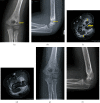Late Deep Infections Complicating Percutaneous Pinning of Supracondylar Humerus Fractures
- PMID: 34631185
- PMCID: PMC8497162
- DOI: 10.1155/2021/7915516
Late Deep Infections Complicating Percutaneous Pinning of Supracondylar Humerus Fractures
Abstract
Objectives: Complications following treatment of supracondylar humerus fractures are typically seen shortly postoperatively. Late complications occurring years after percutaneous pinning are rare but can be indolent and have permanent sequelae. We present cases of children presenting with late deep infections to discuss their diagnosis and treatment.
Methods: After institutional review board approval, we retrospectively reviewed records of three children who developed deep infections at least one year after percutaneous pinning of their supracondylar humerus fracture. Patient details and outcomes were analyzed. Radiographs and magnetic resonance imaging were reviewed along with each patient's clinical course and treatment.
Results: We report 3 cases of osteomyelitis and/or septic arthritis presenting at least one year after supracondylar humerus fractures treated with closed reduction and percutaneous pinning. The patients required several irrigation and debridement procedures with placement of antibiotic beads in addition to a prolonged course of antibiotics.
Conclusion: Delayed deep infections can occur after closed reduction and percutaneous pinning of supracondylar humerus fractures in children. Vigilance is required to diagnose and treat such occurrences, and prolonged follow-up is needed to monitor for recurrent or intractable infections.
Copyright © 2021 Achraf H. Jardaly et al.
Conflict of interest statement
Achraf H. Jardaly, Ketrick LaCoste, Shawn R. Gilbert, and Michael J. Conklin declare that they have no conflict of interest.
Figures


Similar articles
-
Complications and timing of follow-up after closed reduction and percutaneous pinning of supracondylar humerus fractures: follow-up after percutaneous pinning of supracondylar humerus fractures.J Pediatr Orthop. 2004 Nov-Dec;24(6):610-4. doi: 10.1097/00004694-200411000-00002. J Pediatr Orthop. 2004. PMID: 15502556
-
How safe is the operative treatment of Gartland type 2 supracondylar humerus fractures in children?J Pediatr Orthop. 2008 Mar;28(2):139-41. doi: 10.1097/BPO.0b013e3181653ac8. J Pediatr Orthop. 2008. PMID: 18388704
-
Pseudomonas aeruginosa Septic Arthritis and Osteomyelitis after Closed Reduction and Percutaneous Pinning of a Supracondylar Humerus Fracture: A Case Report and Review of the Literature.Case Rep Orthop. 2017;2017:8721835. doi: 10.1155/2017/8721835. Epub 2017 Nov 14. Case Rep Orthop. 2017. PMID: 29348955 Free PMC article.
-
Percutaneous pinning of pediatric supracondylar humerus fractures with the semisterile technique: the Miami experience.J Pediatr Orthop. 2007 Jan-Feb;27(1):17-22. doi: 10.1097/bpo.0b013e31802b68dc. J Pediatr Orthop. 2007. PMID: 17195791 Review.
-
[Supracondylar fractures of the humerus in children].Tidsskr Nor Laegeforen. 2011 Feb 18;131(4):349-52. doi: 10.4045/tidsskr.10.0428. Tidsskr Nor Laegeforen. 2011. PMID: 21339783 Review. Norwegian.
Cited by
-
Progression to Pseudomonas Osteomyelitis Following Pin Tract Infection After Percutaneous Fixation of a Pediatric Supracondylar Humerus Fracture.Cureus. 2025 Jun 30;17(6):e87058. doi: 10.7759/cureus.87058. eCollection 2025 Jun. Cureus. 2025. PMID: 40741564 Free PMC article.
-
Recurrent Infections After Percutaneous Pinning of a Proximal Radius and Ulna Fracture.J Am Acad Orthop Surg Glob Res Rev. 2023 Oct 6;7(10):e23.00081. doi: 10.5435/JAAOSGlobal-D-23-00081. eCollection 2023 Oct 1. J Am Acad Orthop Surg Glob Res Rev. 2023. PMID: 37801633 Free PMC article.
-
Management of Acute Lateral Humeral Condyle Fractures in Children.Children (Basel). 2024 Nov 25;11(12):1421. doi: 10.3390/children11121421. Children (Basel). 2024. PMID: 39767850 Free PMC article. Review.
-
Subtrochanteric Insufficiency Fracture Occurring 5 Years after Surgery at the Steinmann Pin Insertion Site for Fracture Reduction.Medicina (Kaunas). 2022 Mar 9;58(3):404. doi: 10.3390/medicina58030404. Medicina (Kaunas). 2022. PMID: 35334582 Free PMC article.
References
Publication types
LinkOut - more resources
Full Text Sources

